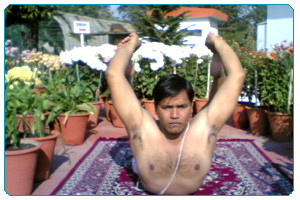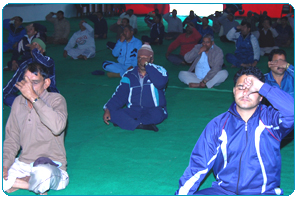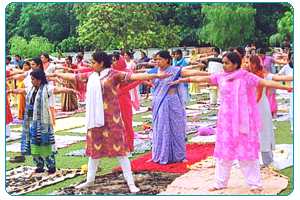|
The
most important benefit of yoga is physical and mental
therapy. The aging process, which is largely an
artificial condition, caused mainly by autointoxication or
self-poisoning, can be slowed down by practicing yoga. By
keeping the body clean, flexible and well lubricated, we can
significantly reduce the catabolic process of cell
deterioration. To get the maximum benefits of yoga one has
to combine the practices of yogasanas, pranayama and
meditation.
Regular practice of asanas, pranayama and meditation can
help such diverse ailments such as diabetes, blood pressure,
digestive disorders, arthritis, arteriosclerosis, chronic
fatigue, asthma, varicose veins and heart conditions.
Laboratory tests have proved the yogi`s increased abilities
of consciously controlling autonomic or involuntary
functions, such as temperature, heartbeat and blood
pressure. Research into the effects of yogic practices on
HIV is currently underway with promising results.
According to medical scientists, yoga therapy is successful
because of the balance created in the nervous and endocrine
systems which directly influences all the other systems and
organs of the body. Yoga acts both as a curative and
preventive therapy. The very essence of yoga lies in
attaining mental peace, improved concentration powers, a
relaxed state of living and harmony in relationships.
Through the practice of yoga, we become aware of the
interconnectedness between our emotional, mental and
physical levels. Gradually this awareness leads to an
understanding of the more subtle areas of existence. The
ultimate goal of yoga is to make it possible for you to be
able to fuse together the gross material (annamaya),
physical (pranamaya), mental (manomaya), intellectual (vijnanamaya)
and spiritual (anandamaya) levels within your being.
 Physiological Benefits
Physiological Benefits
Physicians and scientists are discovering brand new health
benefits of yoga everyday. Studies show it can relieve the
symptoms of several common and potentially life-threatening
illnesses such as arthritis, arteriosclerosis, chronic
fatigue, diabetes, AIDS, asthma and obesity.
 Asthma
Asthma
Studies conducted at yoga institutions in India have
reported impressive success in improving asthma. It has also
been proved that asthma attacks can usually be prevented by
yoga methods without resorting to drugs.
Physicians have found that the addition of improved
concentration abilities and yogic meditation together with
the practice of simple postures and pranayama makes
treatment more effective. Yoga practice also results in
greater reduction in anxiety scores than drug therapy.
Doctors believe that yoga practice helps patients by
enabling them to gain access to their own internal
experience and increased self-awareness.
 Respiration Problems
Respiration Problems
Patients who practice yoga have a better chance of gaining
the ability to control their breathing problems. With the
help of yogic breathing exercises, it is possible to control
an attack of severe shortness of breath without having to
seek medical help. Various studies have confirmed the
beneficial effects of yoga for patients with respiratory
problems.
 High Blood Pressure
High Blood Pressure
The relaxation and exercise components of yoga have a major
role to play in the treatment and prevention of high blood
pressure (hypertension). A combination of biofeedback and
yogic breathing and relaxation techniques has been found to
lower blood pressure and reduce the need for high blood
pressure medication in people suffering from it.
 Pain Management
Pain Management
Yoga is believed to reduce pain by helping the brain`s pain
center regulate the gate-controlling mechanism located in
the spinal cord and the secretion of natural painkillers in
the body. Breathing exercises used in yoga can also reduce
pain. Because muscles tend to relax when you exhale,
lengthening the time of exhalation can help produce
relaxation and reduce tension. Awareness of breathing helps
to achieve calmer, slower respiration and aid in relaxation
and pain management.
Yoga`s inclusion of relaxation techniques and meditation can
also help reduce pain. Part of the effectiveness of yoga in
reducing pain is due to its focus on self-awareness. This
self-awareness can have a protective effect and allow for
early preventive action.
 Back Pain
Back Pain
Back pain is the most common reason to seek medical
attention. Yoga has consistently been used to cure and
prevent back pain by enhancing strength and flexibility.
Both acute and long-term stress can lead to muscle tension
and exacerbate back problems.
 Arthritis
Arthritis
Yoga`s gentle exercises designed to provide relief to needed
joints had been Yoga`s slow-motion movements and gentle
pressures reach deep into troubled joints. In addition, the
easy stretches in conjunction with deep breathing exercises
relieve the tension that binds up the muscles and further
tightens the joints. Yoga is exercise and relaxation rolled
into one - the perfect anti-arthritis formula.
 Weight Reduction
Weight Reduction
Regular yoga practice can help in weight management.
Firstly, some of the asanas stimulate sluggish glands to
increase their hormonal secretions. The thyroid gland,
especially, has a big effect on our weight because it
affects body metabolism. There are several asanas, such as
the shoulder stand and the fish posture, which are specific
for the thyroid gland. Fat metabolism is also increased, so
fat is converted to muscle and energy. This means that, as
well as losing fat, you will have better muscle tone and a
higher vitality level.
Yogic practices that reduce anxiety tend to reduce anxious
eating. In addition, yoga deep breathing increases the
oxygen intake to the body cells, including the fat cells.
This causes increased oxidation or burning up of fat cells.
Yogic exercises induce more continuous and deeper breathing
which gradually burns, sometimes forcefully, many of the
calories already ingested.
 Psychological Benefits
Psychological Benefits
Regular yoga practice creates mental clarity and calmness,
increases body awareness, relieves chronic stress patterns,
relaxes the mind, centers attention and sharpens
concentration.
 Self-Awareness
Self-Awareness
Yoga strives to increase self-awareness on both a physical
and psychological level. Patients who study yoga learn to
induce relaxation and then to use the technique whenever
pain appears. Practicing yoga can provide chronic pain
sufferers with useful tools to actively cope with their pain
and help counter feelings of helplessness and depression.
 Mental Performance
Mental Performance
A common technique used in yoga is breathing through one
nostril at a time. Electroencephalogram (EEG) studies of the
electrical impulses of the brain have shown that breathing
through one nostril results in increased activity on the
opposite side of the brain. Some experts suggest that the
regular practice of breathing through one nostril may help
improve communication between the right and left side of the
brain. Studies have also shown that this increased brain
activity is associated with better performance and doctors
even suggest that yoga can enhance cognitive performance.
 Mood Change And Vitality
Mood Change And Vitality
Mental health and physical energy are difficult to quantify,
but virtually everyone who participates in yoga over a
period of time reports a positive effect on outlook and
energy level. Yogic stretching and breathing exercises have
been seen to result in an invigorating effect on both mental
and physical energy and improved mood.
 Spiritual Benefits
Spiritual Benefits
When you achieve the yogic spirit, you can begin knowing
yourself at peace. The value of discovering one`s self and
of enjoying one`s self as is, begins a journey into being
rather than doing. Life can then be lived practicing "yoga
off the mat".
 Pride Pride
Pride, and especially anxiety about pride, is something
which Hatha Yoga seeks to diminish or eliminate. To one who
has been dejected because he cannot do his work properly
when he becomes tired, irritable, or haggard, any degree of
refreshment may be accompanied by additional degrees of
self-respect. Furthermore, one who has benefited from yoga
may be moved to help his friends who are obviously in need,
he may instruct others and be rewarded with appreciation due
a to teacher.
But if one succeeds in achieving skill which provides health
and self-confidence, one may justly raise his self-esteem
simply by observing himself living the improved results as
an achieved fact.
Knowledge
Yogic theory and practice lead to increased self-knowledge.
This knowledge is not merely that of the practical kind
relating to techniques, but especially of a spiritual sort
pertaining to grasping something about the nature of the
self at rest.
Knowing the self at rest, at peace, as a being rather than
merely as an agent or doer, is a genuine kind of knowledge
which usually gets lost in the rush of activities and push
of desires. The value of discovering one`s self and of
enjoying one`s self as it is, rather than as it is going to
be, is indeed a value as well as a kind of knowledge.
|